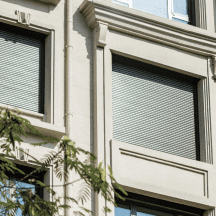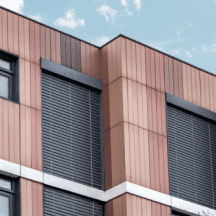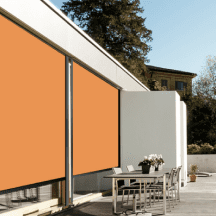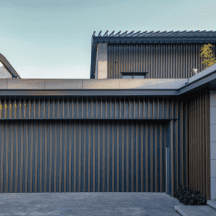MEDIA CENTER
Feb 21th, 2025
Why External Shading is the Most Direct, Effective, and Economical Approach to Building Energy Efficiency
Against the backdrop of global climate change and energy crises, the “Dual Carbon Goals” (carbon peaking and carbon neutrality) have become a core driver for the transformation of the construction industry. Buildings account for over 30% of total societal energy consumption, with windows and openings—the weakest links in a building’s envelope—contributing 40%50% of this energy loss. How can we achieve highefficiency energy savings at the lowest cost? External shading, with its ability to directly intercept solar radiation, flexibly regulate light and heat, and deliver costeffective solutions, has emerged as an indispensable strategy in building energy efficiency. This article explores why external shading is the “optimal solution” from three perspectives: technical principles, practical efficacy, and economic viability.
Most Direct: Intercepting Solar Heat at the Source
The essence of building energy efficiency lies in reducing unnecessary energy loss, and solar radiation is the primary external factor driving indoor temperature fluctuations. Unlike passive measures such as wall insulation or highperformance glazing, external shading operates with proactive intervention—blocking solar radiation at the building’s exterior before heat enters indoor spaces.
Technical Principles:
The Solar Heat Gain Coefficient (SHGC) measures how much heat passes through windows. Even with LowE coatings, traditional glass cannot fully block solar heat. External shading, however, physically obstructs 80%90% of solar heat gain.
Compared to interior or midpane shading, external shading avoids the “lag effect” of heat entering through glass before being blocked, reducing air conditioning loads by 30%50%.
Directness in Action:
Time Dimension: External shading dynamically responds to sunlight changes via smart controls, avoiding the rigidity of fixed shading systems.
Space Dimension: It covers entire window openings, reducing heat radiation at the source without costly structural modifications.
Most Effective: Precision Control of Light and Heat
Building energy efficiency must balance energy savings with indoor comfort. External shading achieves this equilibrium through “lightheat separation” and smart automation.
LightHeat Separation:
Adjustable external shading devices (e.g., roller blinds, louvers) can block heat while preserving natural light. For example, vertical louvers block lowangle sunlight but allow diffused light, minimizing lighting energy use.
Data shows that smartcontrolled external shading reduces total building energy consumption by 20%40%, far outperforming interior shading (5%10%) or midpane solutions (10%15%).
Smart Control Systems:
Sensors monitor real time parameters (light intensity, temperature, wind speed) to automatically adjust shading. For instance, fully closing blinds during summer midday or partially opening them in winter to harness solar warmth.
Compared to manual or basic electric controls, smart systems eliminate underuse or overshading, improving efficiency by over 50%.
Most Economical: Low-cost Investment, High Returns
Building energy efficiency is often perceived as expensive, but external shading offers unparalleled costeffectiveness through low installation costs, ease of integration, and longterm savings.
Initial Cost Advantages:
External shading costs just 1/3 to 1/2 of highperformance glazing per square meter, with no structural alterations required. For example, installing external louvers in a residential building costs 200500 RMB/㎡, versus 8001500 RMB/㎡ for LowE double glazing.
Low Operational Costs:
External shading systems last 1520 years with minimal maintenance. Smart systems may require upfront investment, but energy savings typically repay costs within 35 years. One office building saved 120,000 RMB annually on electricity, achieving a 4year payback period.
Policy Incentives:
Many governments include external shading in green building subsidies. Shanghai, for instance, offers 30%50% subsidies for public buildings adopting external shading, further lowering financial barriers.
Case Studies: Global Success Stories
Germany’s Passive House Standard:
Passive houses (annual energy demand ≤15 kWh/㎡) mandate external shading. A Munich residential project reduced summer cooling energy by 70% and winter heating demand by 45% using smart external shading.
China’s Xiong’an New Area:
A near-zero energy office building integrated external roller blinds with photovoltaic panels, achieving 65% annual energy savings and setting a benchmark for the Dual Carbon Goals.
Small Shading, Big Savings
The “direct, effective, and economical” benefits of external shading are not theoretical—they are validated by physics, technology, and economics. In building energy efficiency, investing in costly structural upgrades or hightech equipment often overlooks the simplest solution: controlling solar heat at the source. As the industry asserts: “No shading, no energy efficiency.” With advancing smart technologies and policy support, external shading will play a pivotal role in transforming buildings from energy guzzlers to sustainable assets, proving that a “small step in shading leads to a giant leap in energy savings.”
Contact us

Kevin
Account Manager

info@ulepanda.com

+86 18551587339

+86 18551587339





